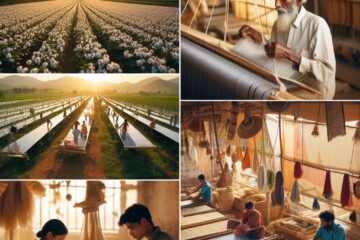In recent years, the fashion industry has become one of the largest contributors to environmental pollution, with an increasing focus on fast fashion and synthetic materials that take hundreds of years to decompose. However, the rise of biodegradable fabrics is offering a glimmer of hope, presenting an opportunity for a more sustainable and eco-friendly future in the world of fashion. These fabrics not only reduce environmental impact but also open up new possibilities for innovative and eco-conscious designs.
What Are Biodegradable Fabrics?
Biodegradable fabrics are textiles made from natural or organic fibers that can be broken down by microorganisms like bacteria, fungi, and enzymes when exposed to natural elements such as air, water, and sunlight. Unlike synthetic materials like polyester or nylon, which are derived from petroleum-based resources and can persist in landfills for centuries, biodegradable fabrics decompose within months or a few years, significantly reducing waste and pollution.
These fabrics are primarily made from renewable resources, such as plant-based materials like cotton, hemp, bamboo, and flax, or from animal fibers like wool and silk. In some cases, even synthetic fibers can be made biodegradable when treated with specific additives that allow for quicker decomposition.
The Environmental Benefits
The environmental benefits of biodegradable fabrics are undeniable. The fashion industry is responsible for around 10% of global carbon emissions and uses vast amounts of water and chemicals in the production of synthetic textiles. Biodegradable fabrics, being made from natural materials, typically require fewer chemicals and less water in their production process. For instance, organic cotton is grown without synthetic pesticides, reducing soil degradation and water pollution, and requires less water compared to conventional cotton farming.
When biodegradable fabrics reach the end of their life cycle, they break down naturally, reducing the burden on landfills. Traditional synthetic fabrics, such as polyester, can take hundreds of years to decompose, releasing harmful microplastics into the environment in the process. On the other hand, biodegradable fabrics pose a significantly lower risk to ecosystems, as they return to the earth in a natural and harmless way.
Innovation in Biodegradable Materials
The future of biodegradable fabrics lies in innovation and the continuous development of sustainable materials. Several innovative textiles are emerging on the market, and companies are experimenting with new materials that offer enhanced biodegradability. One such example is Tencel, a brand name for lyocell, a fabric made from sustainably sourced wood pulp. Tencel is known for its softness, strength, and biodegradability, and its production process uses a closed-loop system that recycles water and solvents, making it an environmentally friendly alternative to conventional textiles.
Another exciting development is in the use of algae and fungi in fabric production. Companies like AlgiKnit and MycoWorks are working on creating fabrics made from algae and mycelium, the root structure of fungi. These materials are not only biodegradable but also have the potential to be even more sustainable than plant-based fibers, as they can be grown with minimal resources and have a faster growth cycle.
Challenges and Limitations
Despite the potential benefits, the widespread adoption of biodegradable fabrics faces some challenges. One of the main obstacles is the cost of production. Biodegradable materials, especially those made from organic or innovative sources, can be more expensive to produce compared to synthetic alternatives. As a result, many eco-friendly fabrics are still limited to high-end, niche fashion brands, though the hope is that advancements in technology and increased demand for sustainable fashion will drive prices down over time.
Moreover, while biodegradable fabrics are environmentally friendly, their overall impact depends on how they are processed, dyed, and treated. The use of toxic dyes or chemical finishes during the manufacturing process can undermine the sustainability of biodegradable fabrics. Therefore, it is essential that brands adopt a holistic approach to sustainability, focusing on all stages of a garment’s life cycle.
The Role of Consumer Awareness
As consumers become more environmentally conscious, there is a growing demand for eco-friendly alternatives in fashion. People are increasingly interested in supporting brands that prioritize sustainability, whether through biodegradable fabrics, ethical manufacturing practices, or transparency in supply chains. This shift in consumer behavior is encouraging brands to explore and invest in eco-friendly materials, ultimately making biodegradable fabrics more accessible and mainstream.
Conclusion
Biodegradable fabrics represent a promising solution for reducing the fashion industry’s environmental impact. As technology advances and consumer demand for sustainable products grows, we can expect biodegradable materials to become a central part of the eco-friendly fashion revolution. While challenges remain, the continued innovation in materials and processes, coupled with heightened consumer awareness, suggests that biodegradable fabrics may very well define the future of fashion—one that is both beautiful and kind to the planet.




